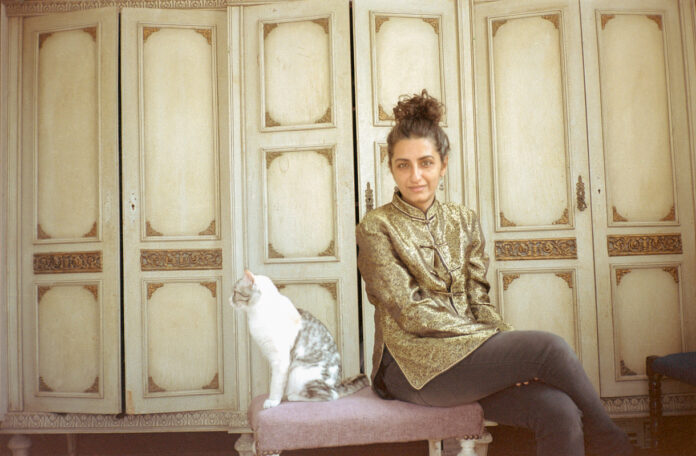BEIRUT: The phrase ‘session musician’ seldom incites an association with visionary artistic expression that carves its own place in the hearts of audiences. Nancy Mounir — an enigmatic yet omnipresent feature of Egypt’s independent music scene — certainly defies that logic.
Mounir was a founding member of Egyptian metal band Massive Scar Era and has long collaborated with renowned artists like Dina El-Wedidi as a producer and arranger. Her extensive resum? also includes composition and sound design work with the likes of theater director Laila Soliman and film director Khairy Beshara.
The chameleonic multi-instrumentalist, who plays violin, piano, bass, theremin, and the traditional Egyptian flute known as kawala, is now releasing her debut solo album, “Nozhet El Nofous” (Promenade of the Souls).
“I have been part of many bands and projects where I happened to arrange and co-produce, and, as a session musician, there are a lot of things you learn when you are getting an alternative music ‘education’ like I did,” Mounir declares nonchalantly about her creative path thus far.
Her label, Simsara Records, bills “Nozhet El Nofous” as a “communion of ghosts.” It epitomizes the understated genius of her immense talent. Mounir has spent five years engaged in an extensive study of Egyptian singers from the early 20th century whose compositions adventurously strode off the beaten path of mainstream Arabic music of the time.
Her label, Simsara Records, bills “Nozhet El Nofous” as a “communion of ghosts.” (Supplied)
In fact, these innovators were largely excommunicated from collective memory by the influential 1932 Congress of Arab Music in Cairo, which did not invite them to participate. Those at the “first scientific symposium on non-European music” — an assembly of composers, scholars, performers and educators — were tasked with modernizing what was considered ‘Arabic’ before then.
This essentially resulted in the removal of ‘foreign’ musical influences (and those introduced by minorities), and, as Mounir explains it, “the standardization of the tuning system for the region.”
She was intrigued by the microtonality and non-metered rhythms emblematic of the apostatic singers’ artistry, deemed superfluous in the aftermath of the Congress.
“I felt like this is the kind of Egyptian music that I can relate to, more so than Umm Kulthum and the rest,” she says. “I found a lot of inspiration in the ‘old intervals,’ or ‘spaces’ between the notes, which is quite different from what we have now.”
She was originally drawn to monophonic vocal performances by Zaki Mourad, Fatma Serry, Hayat Sabry and others because of their poetic expression and emotive authenticity. (Supplied)
According to the versatile musician, the first encounter with the songs she would end up selecting for “Nozhet El Nofous” sparked an “obsession with learning the melodies and getting to know more about this forgotten era.”
“Something happens when you listen to a piece obsessively, especially when you’re an arranger,” she says. “At some point, you start hearing all these deeper layers of the music, and you feel an urge to interact and play with it.”
She was originally drawn to monophonic vocal performances by Zaki Mourad, Fatma Serry, Hayat Sabry and others because of their poetic expression and emotive authenticity.
“There was a lot of freedom and vulnerability in the lyrics, rather than the performativity that would eventually develop within the industry,” Mounir says. “The concerts were also quite small — the dynamic between the performer and the audience was very intimate.”
She opted to remain faithful to the spirit of the original material, weaving instrumental arrangements around the archaic recordings of the crooners’ voices. Indeed, a kind of spectral nostalgia is seared into the tenebrous textures of every song, as Mounir blends past and present seamlessly.
“I didn’t want to quantize any of the tracks,” she says, referring to the digital process of eliminating imprecisions in a recorded performance. “I wanted to keep them as they were, even with all the crackling in the sound.
“All of the songs really move me, especially the way Hayat Sabry and and Zaki Mourad speak to their own hearts as if they’re people, existing outside of the body. I really like that,” she continues.
In a live setting, Mounir draws on her experience in documentary theater and has already performed visually and aurally dramatized versions of the album tracks in Alexandria and Cairo — a video recording was screened at Jazzfest Berlin last November.
“At some of the shows, we’re a quartet — my brother, who is a guitarist, double bassist Ahmed Amin, Youssra El-Hawary on accordion… at others, the setup changes and other instruments are added,” Mounir says. “It really takes on different shapes.”
While she played most of the music on “Nozhet El Nofous” herself, Mounir stresses that the recording process was a family affair. “Everyone that took part is either a close friend or a relative, like my brother,” she says. “The best part was sharing all these wonderful ideas with other musicians.”

